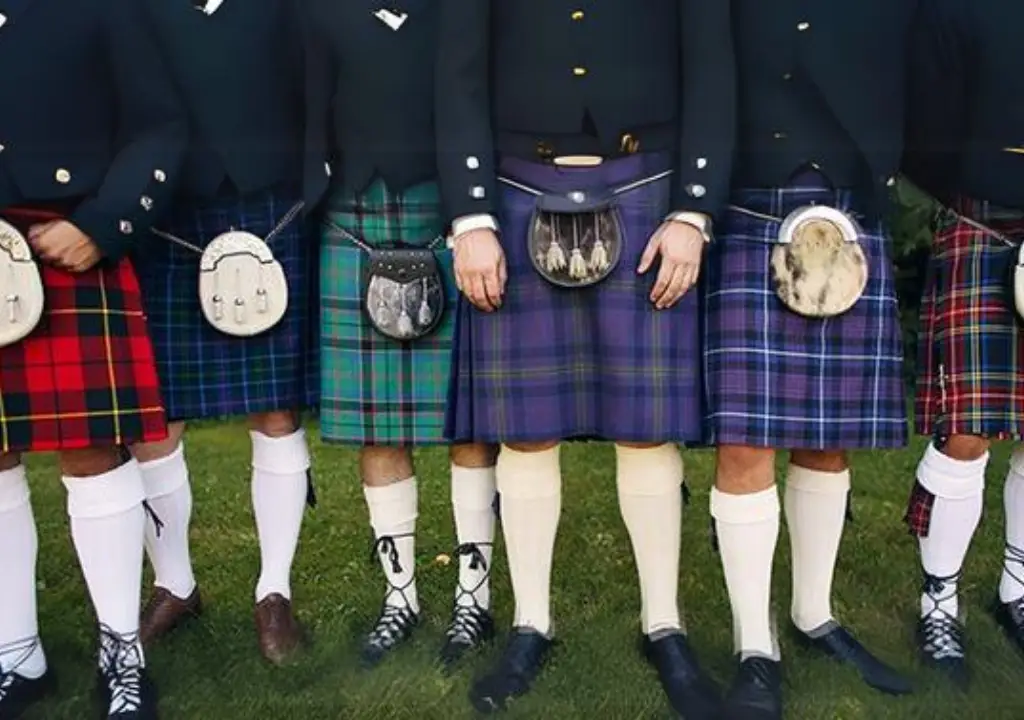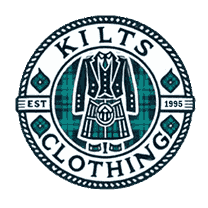What is a Kilt Used For? A Journey Through Time and Function

Kilts are more than just garments; they symbolize Scottish culture, history, and identity. From the rugged Highlands of Scotland to modern-day weddings and festivals, the traditional kilt has evolved in form and function, yet it remains deeply rooted in tradition.
The Origins of the Kilt:
The history of the traditional kilt dates back to the 16th century, with the féileadh mòr or "Great Kilt" being its earliest form. This traditional Scottish clothing was a garment and a blanket, providing warmth and protection against the harsh Scottish weather. The Great Kilt, made from tartan, was an essential part of Highland dress, deeply embedded in the daily lives of the Scottish people. It wasn't just a piece of clothing but a symbol of identity, with each tartan pattern representing a specific Scottish clan.
In addition to its practical uses, the Great Kilt held significant cultural importance. Worn during battles, it symbolized the wearer's allegiance to their clan and was often passed down through generations as a family heirloom. Over time, the kilt evolved from this practical garment into a more tailored and refined Scottish traditional clothing, eventually becoming the iconic garment we recognize today.
The Kilt in Scottish Culture:
In Scottish culture, the traditional kilt is far more than just traditional attire; it is a powerful symbol of heritage. The tartan patterns worn by different clans testify to the deep-rooted connection between the Scottish people and their lineage. Over centuries, kilts have been worn during significant events, such as weddings, Highland games, and even in battle, where they symbolized courage and unity. Today, the kilt remains a strong cultural symbol, worn with pride by men and women alike during formal ceremonies and national celebrations and also used as traditional wedding kilt.
The cultural significance of kilting traditions is evident in how kilts are still used in Scotland today. From the Scottish Highlands to urban centers like Edinburgh and Glasgow, men's and women's kilts are proudly worn during events like Tartan Day and Burns Night, reinforcing the connection between the present and the Scottish history that shaped this iconic garment.
The Evolution of the Kilt:
As times changed, so did the kilt. The Utility Kilt emerged as a modern adaptation designed for practicality rather than ceremonial use. Unlike traditional kilts from heavy wool, utility kilts are crafted from cotton or denim, offering more comfort and versatility. These kilts are popular among those who wish to honor Scottish traditions while embracing contemporary styles. They are functional, often featuring pockets and durable construction, making them suitable for everyday wear, work, or casual events.
This modern evolution of the kilt reflects the blending of tradition and innovation. While the utility kilt offers a more practical alternative to the traditional Scottish kilt, it still maintains the essential characteristics that make it a symbol of Scottish culture. Whether worn in the Scottish Highlands or by kilted men in other parts of the world, the kilt continues to adapt, ensuring its relevance in historical and modern contexts.
Kilts as Ceremonial Dress:
Kilts have maintained their place as ceremonial dress in Scotland and among the Scottish diaspora worldwide. Whether it's a wedding, where men's wedding kilts are worn, or a graduation, kilts are chosen for their rich cultural significance. The Sporran, a pouch worn with the kilt, adds to the ceremonial aspect, often intricately decorated to match the formality of the occasion. Highland dress, including the kilt, remains a staple at events like Tartan Day, Burns Night, and clan gatherings, symbolizing respect for tradition.
The kilt's ceremonial importance is also seen in its use during national and cultural celebrations, such as Scottish independence events or the Highland games. These occasions highlight Scotland's cultural heritage, with participants donning kilts that reflect their Scottish identity and clan heritage. In these contexts, the kilt is more than just clothing; it is a profound expression of Scottish pride and tradition.
The Modern Uses of Kilts:
In modern times, kilts have transcended their traditional roots to become a versatile fashion statement. From casual men's kilts worn at festivals to formal men's tartan kilts for weddings, the kilt has found a place in various settings. Designers have experimented with different fabrics, colors, and patterns, making kilts more accessible and appealing to a broader audience. The men's black kilt is a prime example of this modern adaptation, offering a sleek and stylish option for formal events.
In addition to formal events, kilts are now seen in casual settings, paired with modern attire to create unique looks. This versatility has made kilts a popular choice for both men and women, with the rise of kilts for women contributing to this trend. Whether worn traditionally or in a contemporary style, the kilt remains a powerful symbol of Scottish culture and fashion.
Kilts in Popular Culture:
Kilts have also made their mark in global popular culture. From movie scenes to music videos, the kilt has been featured as a symbol of rebellion, tradition, and style. Celebrities and influencers worldwide have embraced the kilt, further popularizing it beyond Scotland. This global recognition has sparked interest in Scottish culture, leading to a rise in demand for kilts worldwide, especially in places like the United States.
This widespread popularity of the kilt has also led to an increased availability of kilts online, making it easier for people to purchase authentic Scottish kilts no matter where they live. As the kilt continues gaining recognition and appreciation, it bridges Scottish traditions and the global fashion scene, proving its timeless appeal.
The Purpose of Wearing a Kilt:
While the historical significance of kilts cannot be understated, their purpose today extends beyond tradition. Modern kilts are worn for comfort, style, cultural pride, and even practicality. For many, wearing a kilt is a way to connect with their Scottish heritage, while for others, it is simply a unique fashion choice. The kilt's adaptability ensures its place in everyday wear and special occasions.
The purpose of wearing a kilt has also evolved to include expressing individuality and making a fashion statement. Whether a men's kilt outfit for a formal event or a casual kilt outfit for a festival, the kilt allows wearers to showcase their style while honoring a rich cultural tradition. This duality of function and fashion continues to make the kilt a beloved garment worldwide.
Choosing the Right Kilt:
When selecting a kilt, especially for formal events like weddings, it's essential to consider factors such as fabric, tartan pattern, and fit. Measuring for a kilt men's size is crucial to ensure the perfect fit, as kilts are customarily made to order. Additionally, the choice of tartan is significant, as it reflects the wearer's clan or personal connection to Scottish culture. For modern designs, men's kilts offer a range of options, from traditional tartans to contemporary utility styles.
Modern men have many choices when styling a men's kilt outfit. Whether selecting a men's wedding kilt or a casual kilt man look, the right kilt can significantly impact you. Knowing where to buy the best men's kilts and how to choose the appropriate kilt outfit for different occasions is key to embracing this timeless piece of Scottish clothing.
The Cultural Importance of Kilts:
Kilts are culturally important because they preserve Scottish traditions while evolving with the times. They represent a connection to the past, a symbol of Scottish identity, and a celebration of cultural heritage. Whether worn during formal ceremonies or as part of everyday attire, kilts continue to embody the spirit of Scotland, making them an enduring element of Scottish culture.
As Scotland continues to celebrate its rich identity, the kilt continues to be relevant in the modern era. The kilt's adaptability—from traditional clothing to utility kilts—ensures that it remains a significant part of Scottish culture. Whether worn by men at weddings or by women in fashion-forward settings, the kilt is a symbol of historical significance and modern relevance.
This enduring connection to Scottish traditions highlights the kilt's importance in maintaining cultural heritage. As kilts continue to evolve, they preserve the past and adapt to future trends, ensuring that the kilt remains an iconic and cherished symbol of Scotland for generations to come.
Kilts for Women:
While kilts are traditionally associated with men, kilts for women have gained popularity in recent years. Women's kilts, often styled as kilt skirts or ladies' knee-length kilts, offer a feminine take on this iconic garment. These kilts are worn for formal and casual occasions, allowing women to embrace Scottish traditions with a modern twist.
The rise of women's kilts reflects the growing inclusivity of kilting traditions. From formal events like weddings to casual outings, women increasingly choose kilts as a stylish and culturally significant option. This trend not only broadens the appeal of the kilt but also reinforces its status as a versatile and timeless piece of Scottish clothing.
The Future of Kilts:
As kilts continue to evolve, their future looks promising. With increasing interest in Scottish culture and heritage, demand for kilts will likely grow. The kilt's ability to adapt to modern trends while maintaining its traditional roots ensures that it will remain a cherished part of Scottish culture for generations.
The future of kilts also lies in their ability to transcend cultural boundaries and appeal to a global audience. As more people embrace the kilt as a symbol of heritage and fashion, its legacy as a key element of Scottish identity will continue to flourish.
Conclusion:
The journey of the kilt from its origins in the Scottish Highlands to its place in modern wardrobes is a testament to the enduring nature of Scottish culture and identity. This iconic garment, rich in history and symbolism, has evolved over centuries to remain relevant, whether as traditional Scottish clothing or a contemporary fashion statement. The kilt continues to be a powerful symbol of pride, heritage, and tradition, cherished by Scots and admired worldwide.
As kilts continue to adapt to modern trends while preserving their traditional roots, they ensure that the rich legacy of Scottish identity is remembered and celebrated by future generations. Whether worn during formal ceremonies or as part of everyday attire, the kilt serves as a vibrant bridge, connecting Scotland’s cultural heritage from the past to the present in a meaningful and enduring way.
FAQs
A kilt is both practical and symbolic. Traditionally, it provided warmth and comfort in Scotland’s tough climate and could serve as a blanket. Today, it symbolizes Scottish heritage, with different tartans representing various clans.
Kilts are worn in Scotland and by Scottish communities worldwide during cultural events like Highland games, weddings, and national celebrations. They are also used in formal settings and have become popular in modern fashion.
To wear a kilt, wrap it around your waist with the pleats at the back and secure it with straps. Add accessories like a sporran (pouch), kilt pin, and appropriate shoes. Kilts can be dressed up or down, depending on the occasion.
Choose a kilt based on the occasion, the tartan pattern, and the fit. Measure your waist accurately for a proper fit. Traditional wool kilts are great for formal events, while utility kilts are better for casual wear.
Kilts are a symbol of Scottish pride and heritage. Each tartan represents a specific clan, connecting the wearer to their ancestry. Kilts are worn during important cultural events to celebrate and preserve Scottish traditions.



